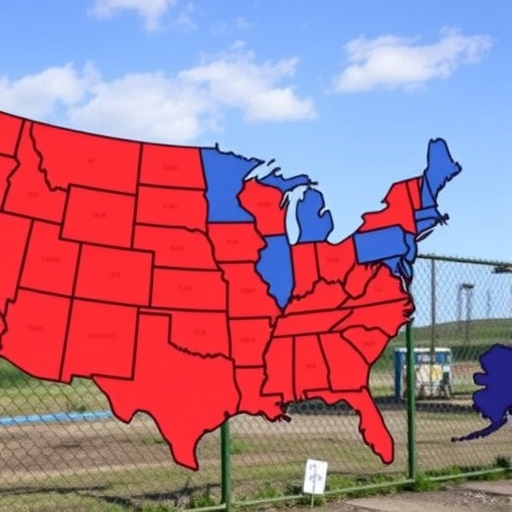Redistricting Battles Heat Up: States Gear Up for High-Stakes 2026 Elections
In a high-stakes game of political chess, Redistricting fights are erupting across the U.S. as states race to redraw congressional and state legislative maps before the 2026 midterm elections. With control of the House of Representatives hanging in the balance, both Democrats and Republicans are deploying lawyers, lobbyists, and grassroots campaigns to tilt the electoral playing field in their favor. Recent court rulings in battleground states like North Carolina and Ohio have already shifted the landscape, potentially adding or subtracting dozens of seats in what experts call the most contentious Redistricting cycle since 2020.
North Carolina’s Supreme Court Showdown Reshapes Southern Politics
North Carolina has emerged as ground zero in the escalating redistricting wars, where a state Supreme Court decision last month overturned a previous map deemed unfairly gerrymandered in favor of Republicans. The court’s 4-3 ruling ordered the redrawing of 14 congressional districts, a move that could hand Democrats up to three additional seats in the 2026 elections. “This isn’t just about lines on a map; it’s about ensuring every voter’s voice is heard,” said Democratic state Rep. Graig Meyer, who has led advocacy efforts for fair maps.
The controversy dates back to 2022, when Republicans, holding a veto-proof majority in the state legislature, approved maps that independent analysts from the Princeton Gerrymandering Project scored as among the most partisan in the nation. Those maps helped secure a 10-3 Republican edge in the state’s congressional delegation. Now, with Democrats regaining control of the governorship in 2024, the pushback has intensified. Population shifts from the 2020 census, showing urban growth in cities like Raleigh and Charlotte, provide ammunition for arguments that the old maps no longer reflect demographic realities.
Statistics underscore the stakes: North Carolina’s voting-age population has grown by over 500,000 since 2010, with a noticeable tilt toward younger, more diverse demographics that lean Democratic. If new maps are enacted by the June 2025 deadline, projections from the Cook Political Report suggest it could flip the delegation to a more balanced 7-6 split, injecting uncertainty into national politics. Republican leaders, undeterred, have appealed to the U.S. Supreme Court, arguing that state courts overstepped federal guidelines under the Voting Rights Act.
Local activists are mobilizing too. Groups like the Southern Coalition for Social Justice have filed amicus briefs highlighting racial gerrymandering concerns, pointing to data showing Black voters—about 20% of the electorate—were disproportionately packed into fewer districts. “Redistricting is the original sin of American politics,” noted gerrymandering expert Justin Levitt, a law professor at Loyola Marymount University. “In North Carolina, we’re seeing how it perpetuates inequality.” As deadlines loom, public hearings scheduled for March 2025 in Raleigh promise to draw thousands, turning the process into a spectacle of partisan theater.
Ohio Republicans Dig In Against Democratic Map Challenges
Meanwhile, in Ohio, Republican-dominated legislative committees are defending aggressively gerrymandered maps against a barrage of Democratic lawsuits, setting the stage for prolonged battles that could influence Midwestern politics ahead of 2026. The state’s current congressional map, upheld by the Ohio Supreme Court in a narrow 4-3 decision in late 2024, is projected to deliver Republicans 12 of 15 seats despite the state voting for Joe Biden by a slim margin in 2020. This disparity has fueled accusations of extreme partisanship, with metrics from the Campaign Legal Center indicating the map favors the GOP by a whopping 15-point margin.
Democrats, led by the Ohio Democratic Party and backed by national organizations like the Brennan Center for Justice, argue that the maps violate the state constitution’s anti-gerrymandering provisions adopted in 2018. “Ohioans voted for fair districts, not a rigged system that silences the majority,” stated state Sen. Nickie Antonio, the minority leader. Court filings cite specific examples, such as the splitting of Cleveland’s urban core across districts to dilute Democratic strength, a tactic that has drawn comparisons to historical packing and cracking strategies.
Population data from the U.S. Census Bureau reveals Ohio’s challenges: the state lost over 27,000 residents between 2010 and 2020, with declines concentrated in rural, Republican-leaning areas. Urban centers like Columbus and Cincinnati, however, have seen modest growth, providing Democrats leverage to demand more competitive districts. If successful, these challenges could open up three or four seats, according to simulations by the Redistricting Data Hub at Princeton University.
Republicans counter that their maps adhere to compactness and contiguity rules, emphasizing that Democrats control key urban areas and should not complain about outcomes. Gov. Mike DeWine has publicly supported the current configuration, warning that further changes could lead to endless litigation. As of February 2025, over 20 lawsuits are pending in Ohio courts, with appeals likely heading to the federal level. This deadlock exemplifies broader state-level politics, where control of redistricting commissions or legislatures determines electoral futures.
Texas Emerges as a Flashpoint for Racial and Partisan Tensions
Texas, with its explosive population growth and diverse electorate, is witnessing redistricting battles that blend partisan maneuvering with Voting Rights Act disputes, potentially altering the trajectory of Southern politics for 2026. The Republican-led legislature redrew maps in 2021 following the 2020 census, which showed the state gaining two congressional seats due to an influx of over 4 million residents. However, Latino advocacy groups, representing nearly 40% of Texans, have sued, claiming the new lines dilute minority voting power in districts around Houston and San Antonio.
A federal court in Galveston is set to rule on these challenges by April 2025, with plaintiffs arguing that maps in Congressional Districts 15 and 23 crack Latino communities to benefit white Republican incumbents. “This is voter suppression by another name,” said Texas ACLU director Andre Segura. Data from the Texas Civil Rights Project supports this, showing that under the current maps, Latino voters—who make up 25% of the congressional delegation’s electorate—are underrepresented compared to their population share.
Democrats see an opportunity to gain ground in a state that hasn’t voted for a Democratic presidential candidate since 1976. With urban growth in Dallas-Fort Worth and Austin suburbs trending blue, fairer maps could create two or three competitive seats, per estimates from the Niskanen Center. Republicans, holding a 25-13 majority in the Texas House delegation, defend the maps as neutral, pointing to compliance with federal preclearance requirements post-Shelby County v. Holder.
The intrigue deepened when a leaked memo from the Texas Attorney General’s office revealed internal discussions about “defensive gerrymandering” to protect against future Democratic gains. Public backlash has been swift, with protests in Austin drawing over 5,000 participants in January 2025. As Texas politics heats up, the outcome here could serve as a bellwether for how redistricting intersects with demographic shifts, influencing not just 2026 elections but the national balance of power.
National Implications: How Redistricting Could Tip the Scales in 2026
Beyond individual states, the nationwide redistricting frenzy is poised to reshape the 2026 midterm elections, where all 435 House seats and 33 Senate races are on the line. Analysts from the Brookings Institution predict that map changes in just 10 key states could swing control of the House by 10 to 15 seats, making redistricting the defining issue of this cycle. With Republicans holding a slim 220-215 majority as of early 2025, even minor adjustments carry outsized weight.
Key statistics highlight the volatility: The 2020 redistricting cycle, delayed by the pandemic, led to a net gain of five Republican House seats through gerrymandering, according to the American Political Science Association. This time, Democrats are better prepared, having invested over $50 million in state-level races since 2022 to flip legislative majorities in places like Michigan and Minnesota, where independent commissions now draw maps.
Quotes from political insiders underscore the urgency. “Redistricting is the silent killer of democracy,” warned former House Speaker Nancy Pelosi in a recent op-ed. On the Republican side, National Republican Redistricting Trust chairman Ben Ginsberg touted their strategy: “We’re focused on data-driven maps that reflect conservative values.” Bipartisan efforts, such as those in Colorado and Virginia using citizen commissions, offer a glimmer of hope, producing maps scored as neutral by the League of Women Voters.
Looking ahead, the U.S. Supreme Court may play a pivotal role, with cases from Alabama and Louisiana already testing the boundaries of racial gerrymandering under Section 2 of the Voting Rights Act. If conservative justices uphold restrictive interpretations, it could embolden Republican mapmakers in states like Florida and Georgia. Conversely, progressive wins in state courts might inspire a wave of challenges, extending battles into 2026.
For voters, the ramifications are profound. Redistricting affects not only who wins elections but also policy outcomes on issues like healthcare, climate, and education. In states like Pennsylvania, where a fairer map in 2022 helped Democrats gain seats, turnout surged by 8% in subsequent cycles, per Pew Research Center data. As 2026 approaches, grassroots organizations are ramping up voter education campaigns, urging participation in public comment periods.
The path forward involves a patchwork of deadlines: Some states must finalize maps by summer 2025, while others await federal guidance. International observers, including those from the OSCE, have noted U.S. redistricting as a vulnerability in democratic processes, potentially influencing global perceptions of American politics. Ultimately, these battles will determine whether 2026 delivers a wave election or entrenches the status quo, with states serving as the battlegrounds for the nation’s political soul.
In the coming months, expect more lawsuits, legislative showdowns, and perhaps even ballot initiatives in states like Utah and Idaho pushing for reform. The stakes couldn’t be higher: A balanced map could foster competitive elections, encouraging politicians to appeal to moderates, while skewed ones risk deepening polarization. As one election law expert put it, “2026 isn’t just about who draws the lines—it’s about who gets to cross them.”









